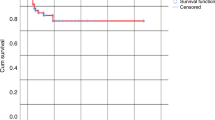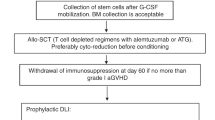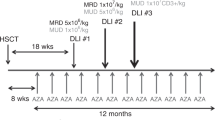Summary:
Donor lymphocyte infusion has become established as a salvage therapy for patients with hematological disorders relapsing after allogeneic bone marrow transplantation (BMT). The role of donor lymphocyte infusion for patients with myelodysplastic syndrome (MDS) remains to be established. Between July 1993 and October 2001, 14 patients with MDS relapsing after allogeneic BMT received DLI as salvage therapy. At the time of BMT, one patient had RA, nine had RAEB, of whom three were in CR after induction-type chemotherapy, two had RAEB-T, one had CMML and one had AML. Donors were HLA-matched siblings (n=12), HLA-matched other relative (n=1) and unrelated (n=1). At the time of relapse, the median marrow blast count was 9%. The median CD3+ cell dose administered was 6.3 × 107/kg. With a median follow-up of 49 months, six patients were alive, of whom two were in CR after DLI alone and remained disease-free, two were in CR after a second BMT and two had active disease. Eight patients died of disease progression. Although DLI alone seems to be effective in a small number of patients with MDS, other treatment strategies, including prior debulking chemotherapy, deserve investigation.
This is a preview of subscription content, access via your institution
Access options
Subscribe to this journal
Receive 12 print issues and online access
$259.00 per year
only $21.58 per issue
Buy this article
- Purchase on Springer Link
- Instant access to full article PDF
Prices may be subject to local taxes which are calculated during checkout
Similar content being viewed by others
References
Picozzi Jr VJ, Swanson GF, Morgan R et al. 13-cis retinoic acid treatment for myelodysplastic syndromes. J Clin Oncol 1986; 4: 589–595.
Koeffler HP, Hirji K, Itri L . 1,25-Dihydroxyvitamin D3: in vivo and in vitro effects on human preleukemic and leukemic cells. Cancer Treat Rep 1985; 69: 1399–1407.
Elias L, Hoffman R, Boswell S et al. A trial of recombinant alpha 2 interferon in the myelodysplastic syndromes: I. Clinical results. Leukemia 1987; 1: 105–110.
Gradishar WJ, Le Beau MM, O'Laughlin R et al. Clinical and cytogenetic responses to granulocyte–macrophage colony-stimulating factor in therapy-related myelodysplasia. Blood 1992; 80: 2463–2470.
Anderson JE, Appelbaum FR, Fisher LD et al. Allogeneic bone marrow transplantation for 93 patients with myelodysplastic syndrome. Blood 1993; 82: 677–681.
Sutton L, Chastang C, Ribaud P et al. Factors influencing outcome in de novo myelodysplastic syndromes treated by allogeneic bone marrow transplantation: a long-term study of 71 patients. Societe Francaise de Greffe de Moelle. Blood 1996; 88: 358–365.
Arnold R, de Witte T, van Biezen A et al. Unrelated bone marrow transplantation in patients with myelodysplastic syndromes and secondary acute myeloid leukemia: an EBMT survey. European Blood and Marrow Transplantation Group. Bone Marrow Transplant 1998; 21: 1213–1216.
Yakoub-Agha I, de La Salmoniere P, Ribaud P et al. Allogeneic bone marrow transplantation for therapy-related myelodysplastic syndrome and acute myeloid leukemia: a long-term study of 70 patients – report of the French society of bone marrow transplantation. J Clin Oncol 2000; 18: 963–971.
Cullis JO, Schwarer AP, Hughes TP et al. Second transplants for patients with chronic myeloid leukaemia in relapse after original transplant with T-depleted donor marrow: feasibility of using busulphan alone for re-conditioning. Br J Haematol 1992; 80: 33–39.
Chiang KY, Weisdorf DJ, Davies SM et al. Outcome of second bone marrow transplantation following a uniform conditioning regimen as therapy for malignant relapse. Bone Marrow Transplant 1996; 17: 39–42.
Kishi K, Takahashi S, Gondo H et al. Second allogeneic bone marrow transplantation for post-transplant leukemia relapse: results of a survey of 66 cases in 24 Japanese institutes. Bone Marrow Transplant 1997; 19: 461–466.
Slavin S, Naparstek E, Nagler A et al. Allogeneic cell therapy with donor peripheral blood cells and recombinant human interleukin-2 to treat leukemia relapse after allogeneic bone marrow transplantation. Blood 1996; 87: 2195–2204.
Drobyski WR, Hessner MJ, Klein JP et al. T-cell depletion plus salvage immunotherapy with donor leukocyte infusions as a strategy to treat chronic-phase chronic myelogenous leukemia patients undergoing HLA-identical sibling marrow transplantation. Blood 1999; 94: 434–441.
Porter DL, Collins Jr RH, Hardy C et al. Treatment of relapsed leukemia after unrelated donor marrow transplantation with unrelated donor leukocyte infusions. Blood 2000; 95: 1214–1221.
Guglielmi C, Arcese W, Dazzi F et al. Donor lymphocyte infusion for relapsed chronic myelogenous leukemia: prognostic relevance of the initial cell dose. Blood 2002; 100: 397–405.
Collins Jr RH, Shpilberg O, Drobyski WR et al. Donor leukocyte infusions in 140 patients with relapsed malignancy after allogeneic bone marrow transplantation. J Clin Oncol 1997; 15: 433–444.
Porter DL, Roth MS, Lee SJ . Adoptive immunotherapy with donor mononuclear cell infusions to treat relapse of acute leukemia or myelodysplasia after allogeneic bone marrow transplantation. Bone Marrow Transplant 1996; 18: 975–980.
Helg C, Starobinski M, Jeannet M, Chapuis B . Donor lymphocyte infusion for the treatment of relapse after allogeneic hematopoietic stem cell transplantation. Leuk Lymphoma 1998; 29: 301–313.
Shiobara S, Nakao S, Ueda M et al. Donor leukocyte infusion for Japanese patients with relapsed leukemia after allogeneic bone marrow transplantation: lower incidence of acute graft-versus-host disease and improved outcome. Bone Marrow Transplant 2000; 26: 769–774.
Bennett JM, Catovsky D, Daniel MT et al. Proposals for the classification of the myelodysplastic syndromes. Br J Haematol 1982; 51: 189–199.
Glucksberg H, Storb R, Fefer A et al. Clinical manifestations of graft-versus-host disease in human recipients of marrow from HL-A-matched sibling donors. Transplantation 1974; 18: 295–304.
Novitzky N, Rubinstein R, Hallett JM et al. Bone marrow transplantation depleted of T cells followed by repletion with incremental doses of donor lymphocytes for relapsing patients with chronic myeloid leukemia: a therapeutic strategy. Transplantation 2000; 69: 1358–1363.
Dazzi F, Szydlo RM, Craddock C et al. Comparison of single-dose and escalating-dose regimens of donor lymphocyte infusion for relapse after allografting for chronic myeloid leukemia. Blood 2000; 95: 67–71.
Sierra J, Perez WS, Rozman C et al. Bone marrow transplantation from HLA-identical siblings as treatment for myelodysplasia. Blood 2002; 100: 1997–2004.
Guardiola P, Runde V, Bacigalupo A et al. Retrospective comparison of bone marrow and granulocyte colony-stimulating factor-mobilized peripheral blood progenitor cells for allogeneic stem cell transplantation using HLA identical sibling donors in myelodysplastic syndromes. Blood 2002; 99: 4370–4378.
Kroger N, Schetelig J, Zabelina T et al. A fludarabine-based dose-reduced conditioning regimen followed by allogeneic stem cell transplantation from related or unrelated donors in patients with myelodysplastic syndrome. Bone Marrow Transplant 2001; 28: 643–647.
Parker JE, Shafi T, Pagliuca A et al. Allogeneic stem cell transplantation in the myelodysplastic syndromes: interim results of outcome following reduced-intensity conditioning compared with standard preparative regimens. Br J Haematol 2002; 119: 144–154.
Author information
Authors and Affiliations
Consortia
Corresponding author
Rights and permissions
About this article
Cite this article
Depil, S., Deconinck, E., Milpied, N. et al. Donor lymphocyte infusion to treat relapse after allogeneic bone marrow transplantation for myelodysplastic syndrome. Bone Marrow Transplant 33, 531–534 (2004). https://doi.org/10.1038/sj.bmt.1704381
Received:
Accepted:
Published:
Issue Date:
DOI: https://doi.org/10.1038/sj.bmt.1704381
Keywords
This article is cited by
-
Cytotect®CP as salvage therapy in patients with CMV infection following allogeneic hematopoietic cell transplantation: a multicenter retrospective study
Bone Marrow Transplantation (2018)
-
Donor-lymphocyte infusion following haploidentical hematopoietic cell transplantation with peripheral blood stem cell grafts and PTCy
Bone Marrow Transplantation (2017)
-
Infusion of donor lymphocytes expressing the herpes simplex virus thymidine kinase suicide gene for recurrent hematologic malignancies after allogeneic hematopoietic stem cell transplantation
International Journal of Hematology (2015)
-
Sustained disease-free survival achieved with withdrawal of immunosuppression after rapid relapse of myelodysplastic syndrome following myeloablative allogeneic hematopoietic transplantation: a case report
Journal of Medical Case Reports (2013)
-
Monosomal karyotype predicts poor survival after allogeneic stem cell transplantation in chromosome 7 abnormal myelodysplastic syndrome and secondary acute myeloid leukemia
Leukemia (2013)



